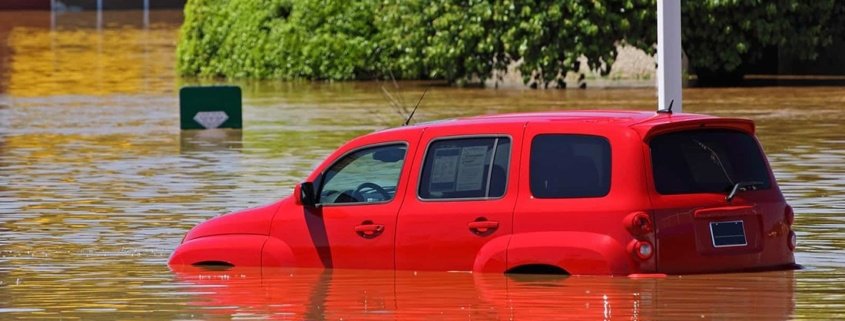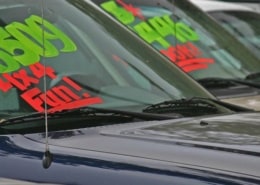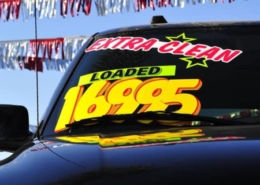How to Recognize and Avoid Flood Damaged Cars
When you buy a used car, you probably think about the possibility of accidental damage. Perhaps the paint on the fender doesn’t quite match that on the door. Maybe the plastic on one headlight is a little clearer than the other.
These things should not deter you if the repairs are done professionally, though you may try negotiating a lower price. What about flood damage, though?
What Can Water Do to a Car?
Flood damage is expensive to repair, so their insurance companies often total vehicles with flood damage. Many will then be restored and resold. Flood-damaged cars are typically identified on their title, but some less scrupulous sellers avoid this. That’s because flood damage takes a big bite out of the value of a car. Quite simply, most car buyers don’t want a vehicle immersed in dirty water for a good reason.
There are three scenarios to consider. Think of them as Bad, Worse, and Dreadful. Bad is when the water rises around a parked car. It gets into the passenger compartment, soaking carpets, seats, and electronics. It fills the engine bay, diluting or washing away lubricating oils and replacing them with dirt and grit. And it can get into the braking system, fuel tank, and fuel lines.
Worse is when someone drives the vehicle into floodwater. This happens a lot with flooded underpasses. The driver plows through what looks like a few inches of water, only to find that it’s much more profound. Water gets drawn through the intake system and into the engine. Unlike the fuel and air mixture the engine expects, water is incompressible. Hence, as the pistons rise in flooded cylinders, the engine locks solid, often sustaining severe damage.
Dreadful is when the flooding is from seawater. While the immediate damage is the same as for river or rainwater, saltwater is far more corrosive and the long-term consequences even more destructive.
Long Term Consequences
If carpets and upholstery do not get replaced after sitting in water, they’re liable to develop mildew. Components that need lubrication – suspension parts and door hinges, for example – will likely suffer rapid wear. Brake fluid absorbs moisture that boils when the brakes get hot. And an engine that’s flooded and locked will need a complete rebuild or replacement.
More insidious is the effect of corrosion. Exposed screws will rust quickly. Silt in the bottom of doors makes an excellent breeding ground for rust, and most serious of all, circuit boards will corrode. This leads to electrical problems, like windows, fans, and CD players that won’t work or airbags that trigger for no apparent reason. (That last one can be nasty!)
How to Spot a Flood Damaged Car
If you live in an area where a storm or hurricane has hit – Sandy and, of course, Harvey is the most recent examples – it should be evident that you need to look for flood damage. But living outside of Texas, New York, or New Jersey doesn’t put you in the clear.
Rivers can burst their banks, and underpasses fill with water anywhere; plus, cars from those recently flooded areas may be taken out of State and sold.
Just because you’re in Michigan or Ohio doesn’t mean a car flooded by Harvey can’t make its way to you. And don’t forget that new cars at dealerships can get flooded too!
When a body shop repairs a flooded car, the damage is often hard to spot. My article on “How to Avoid Buying a Flood-Damaged Car” goes into a little more depth. However, here are three things you can do immediately to protect yourself.
3 steps to protect yourself from buying a flood-damaged vehicle:
- Run a vehicle history report.
- Pay for a professional inspection.
- Use your nose and eyes.
Let’s take a deeper dive into these, (if that’s not too watery a metaphor!)
Vehicle History Report
There are several commercial services you can use. If the vehicle you’re looking at was ever totaled, these should have a record. These reports will sometimes also tell you if the car was registered in an area that suffered flooding.
An address in an area that flooded doesn’t tell you if the car had been immersed. It’s always possible that the owner moved it to higher ground before the water arrived.
Which company is the best?
With several used car history report services online, deciding which one will give you the most value for your money can be challenging. I’ve personally pulled thousands of history reports in my car career.
These companies can be broken down into two categories:
- Not recommended – Low-cost report providers that provide limited information gathered from the Federal Government National Motor Vehicle Title Information System (NMVTIS). I’ve used several of these companies only to find out they consistently miss valuable information when researching the paper trail history of a car. (Keep in mind, there’s a reason they’re cheap!)
- Recommended – Trusted companies that will seek as much data as possible to provide you with the most information about the vehicle so you can make a good buying decision. These companies’ missions are to be the best vehicle history providers in the business and even provide a guarantee on the information provided in their reports.
I’ve used many of these online services in my dealerships to protect myself, the dealership, and my customers from buying an unreliable car. Reviewing a used car’s history report is not a requirement.
However, it should be yours with the rise of unethical practices within the car industry. It’s becoming more critical when uncovering underlying problems not visible to the naked eye.
Best Value for the Money
Most companies only allow you to buy one report at a time, or they will sell you a small package of just 3-5 reports. This will limit you if you’re browsing several vehicles at one time.
We recommend AutoCheck Vehicle History Reports; they are an Experian company. You may not have heard of them because they don’t advertise like the others. Most major auto auctions and lenders use AutoCheck over their competitors because they accurately disclose vehicles that have been rebuilt or branded with frame damage.
We highly recommend the “Multiple Reports Package,” which allows you to run five vehicle history reports for 21 days. This will also inform you if the title’s branded with flood damage. It will give you enough time to research and compare as many vehicles as needed to make a good buying decision. If you think you have to run more reports, you can opt for the Unlimited Package, which allows you to run unlimited reports for three weeks.
With AutoCheck’s Multiple Report plan, you can even run history checks from your Smartphone, tablet, or iPad while looking at vehicles on the dealer’s lot.
Single Vehicle History Report $24.99 – This option will allow you to run your report within 30 days of purchasing. If you know the exact car you’re looking to buy, this option will let you get all the data you need to make a good buying decision. Click here for a single AutoCheck report.
The Multiple Report Package (Best Value) $49.99 – If you’re unsure of the car you want to buy. With this package, you can run up to 25 reports for 21 days, giving you peace of mind that you purchased a reliable used car. Click here for the AutoCheck Multiple Report Package.
Other Options
Another option is The National Motor Vehicle Title Information System (NMVTIS). Run by the Department of Justice, for a small fee, this should indicate whether a vehicle has been flooded. However, as stated above, you get what you pay for. You may not get as readily available information as on an AutoCheck Vehicle History report.
None of these systems are infallible, though, and a vehicle can slip through (or, more likely, for a shady repairer to duck the system.) For this reason, a thorough inspection is always advisable.
Please read more in my complete guide on used car vehicle history reports.
Professional Inspection by a Certified Technician
A certified mechanic will inspect the vehicle you’re thinking of buying for a fee. You can find inspection services online: ensure they are reputable and qualified!
Nose and Eyes
Before deciding whether to spend money on an inspection or a history check, take a good look at the vehicle. Any musty odor should be an immediate red flag, but so should an interior reeking of air freshener. Ask yourself what that’s hiding!
Likewise, if the carpets seem new or the seats have been out, you’d be wise to suspect flood damage. (You can tell if the seats have been removed because the screw heads in place will likely be marked.)
Flood water carries a lot of dirt and debris, and getting this out of every corner is tough. Check the nooks and crannies in the trunk (lift any carpet for a better look) and under the hood. While you’re poking around, look for any rusty screw heads. These get some corrosion protection at the factory, but it’s not enough to ward off the effects of flooding, especially in saltwater.
The light clusters and drain plugs on the floor are two other points to check. Look for watermarks on the headlight lenses and reflectors. You might find some evidence in these areas if the water was high enough.
Drain plugs are put in when the car is painted at the factory and are sometimes visible from underneath. It will be evident if they’ve been removed at some point to let the water run out.
Buyer Beware
When floodwater recedes, there are a lot of calls to insurance companies. It’s estimated that insurance companies scrapped a quarter-million vehicles after Superstorm Sandy, and projections for Harvey losses are currently hovering at about a million vehicles. That means many flood-damaged vehicles could find their way onto the used car market over the coming months.
Flood water does a lot of damage to cars and trucks. While a flood-damaged vehicle will probably sell cheaply, it will have problems in store for the next owner. Not checking for signs of water damage could be a costly mistake.
Be a Savvy Car Shopper
The number one tip for saving the most money when shopping for a new or used car is to always, “DO YOUR HOMEWORK FIRST!” For more hints and tips on navigating the new and used car buying process, spend a little time upfront before beginning your car shopping journey by browsing through my 100% free online car buying guide – AutoCheatSheet.com.
I recommend using an online referral service such as Ryde Shopper or Motor Trend before visiting a car dealership. Their free online price quotes will automatically include any discounts or cash-back incentives currently available in the marketplace.














